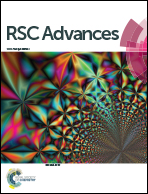Fluoride adsorption on a cubical ceria nanoadsorbent: function of surface properties†
Abstract
Fluoride adsorption onto a cubical ceria nanoadsorbent has been explored using batch as well as column studies, under various experimental conditions such as ionic strength, pH, surface loading, and the influence of major co-existing anions. High adsorption (Langmuir adsorption capacity; 80.64 mg g−1) was attained at pH 7.0 within 2 h at an adsorbent dose of 1 g L−1. Involvement of an inner-sphere complexation mechanism (ligand exchange mechanism) of fluoride adsorption has been confirmed by Fourier transform infrared spectroscopy (FTIR), O 1s X-ray photoelectron spectroscopy (XPS) and zeta potential (ζ) studies where, ligand exchange between the metal–hydroxyl (M–OH) groups and fluoride ions took place. X-ray powder diffraction (XRD) showed the amorphous nature of the developed nanoadsorbent, responsible for the high removal efficiency. The point of zero charge of the developed nanoadsorbent shifted from pH 6 to 5 after fluoride adsorption indicating the specific adsorption of fluoride. Real water analysis using fixed column adsorption indicated that the effectively treatable volume of water was ∼130-bed volume (BV) when the breakthrough point was set at 1.5 mg L−1. The cost benefit analysis demonstrated the better economic viability of the developed cubical ceria nanoadsorbent for fluoride removal compared to other traditional adsorbents.



 Please wait while we load your content...
Please wait while we load your content...